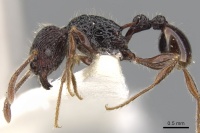Tetramorium sculptatum
| Tetramorium sculptatum | |
|---|---|

| |
| Scientific classification | |
| Kingdom: | Animalia |
| Phylum: | Arthropoda |
| Class: | Insecta |
| Order: | Hymenoptera |
| Family: | Formicidae |
| Subfamily: | Myrmicinae |
| Tribe: | Crematogastrini |
| Genus: | Tetramorium |
| Species: | T. sculptatum |
| Binomial name | |
| Tetramorium sculptatum Bolton, 1977 | |
Specimen records note litter sample collections from a mossy rainforest and Araucaria forest.
Identification
Bolton (1977) - The very distinctive cephalic sculpture and lack of antennal scrobes distinguish this species from others of the group.
Distribution
Latitudinal Distribution Pattern
Latitudinal Range: -5.12033° to -13.71666622°.
| North Temperate |
North Subtropical |
Tropical | South Subtropical |
South Temperate |
- Source: AntMaps
Distribution based on Regional Taxon Lists
Indo-Australian Region: New Guinea.
Distribution based on AntMaps
Distribution based on AntWeb specimens
Check data from AntWeb
Countries Occupied
| Number of countries occupied by this species based on AntWiki Regional Taxon Lists. In general, fewer countries occupied indicates a narrower range, while more countries indicates a more widespread species. |

|
Estimated Abundance
| Relative abundance based on number of AntMaps records per species (this species within the purple bar). Fewer records (to the left) indicates a less abundant/encountered species while more records (to the right) indicates more abundant/encountered species. |

|
Biology
Castes
Nomenclature
The following information is derived from Barry Bolton's Online Catalogue of the Ants of the World.
- sculptatum. Tetramorium sculptatum Bolton, 1977: 109, fig. 26 (w.) PAPUA NEW GUINEA.
Unless otherwise noted the text for the remainder of this section is reported from the publication that includes the original description.
Description
Worker
Holotype. TL 4.1, HL 1.00, HW 0.90, CI 90, SL 0.76, SI 84, PW 0.68, AL 1.20.
Mandibles striate; anterior clypeal margin entire and weakly convex. Frontal carinae short, ending at the level of the posterior margins of the eyes, not more strongly developed than the surrounding longitudinal sculpture and quite inconspicuous. Antennal scrobes absent. Maximum diameter of eyes c. 0'18. Propodeal spines long and acute, feebly downcurved along their length. On the holotype the right hand spine more strongly curved than the left; in some paratypes the spines are very weakly sinuate. Metapleural lobes elongate and acute. Petiole in profile with a long peduncle; node shape showing considerable variation in type-series due to the variable obliteration of the anterodorsal angle. The limits of this variation as shown in the type-series are given in Fig. 26. Clypeus with seven carinae in holotype (in paratype series varying from 5-7, one pair of carinae being variably developed). Dorsum of head very coarsely, regularly and densely longitudinally carinate-rugose or appearing sulcate, with about 12 longitudinal components between the frontal carinae at the level of the eyes. Behind the level of the eyes the sculpture diverges strongly and runs off the dorsum of the head and down the sides, intersecting the lateral outline of the head (full-face view) in the posterior two-thirds or so of the sides behind the eyes. Dorsal alitrunk coarsely reticulate-rugose or reticulate-foveolate, the raised portions rounded and the reticulum itself very irregular. In some para types this sculpture is reduced and in one or two is almost effaced so that the surface is almost smooth but with irregular rounded elongate prominences. Petiole and postpetiole rugose, the dorsum of the postpetiole less strongly so than the sides. Gaster unsculptured. All dorsal surfaces of head and body with numerous fine hairs, those on the dorsal (outer) surface of the hind tibiae very short, much less than the maximum tibial width. Colour very dark blackish brown to black, the appendages somewhat lighter.
Paratype. As holotype and with the variation mentioned above, but also in many the frontal carinae confluent with one component of the longitudinal sculpture on the dorsum of the head. Size range TL 3.8-4.4, HL 0.90-1.06, HW 0.84-0.96, CI 88-93, SL 0.70-0.82, SI 80-87, PW 0.62-0.74, AL 1.10-1.34.
Maximum diameter of eye 0.14-0.18 (21 measured).
Type Material
Holotype worker, Papua New Guinea: Wau, l.vii.1974, 4000 ft, for. litter (S. Peck) (Museum of Comparative Zoology). Paratypes. Papua New Guinea: 8 workers with same data as holotype; 13 workers, Mt Hagen area, 5.vii.1974, c. 2000 m, no. B-280 (S. Peck) (MCZC; The Natural History Museum; Naturhistorisches Museum, Basel; Musee d'Histoire Naturelle Genève).
References
- Bolton, B. 1977. The ant tribe Tetramoriini (Hymenoptera: Formicidae). The genus Tetramorium Mayr in the Oriental and Indo-Australian regions, and in Australia. Bulletin of the British Museum (Natural History). Entomology. 36:67-151. (page 109, fig. 26 worker described)
References based on Global Ant Biodiversity Informatics
- Bolton B. 1977. The ant tribe Tetramoriini (Hymenoptera: Formicidae). The genus Tetramorium Mayr in the Oriental and Indo-Australian regions, and in Australia. Bulletin of the British Museum (Natural History). Entomology 36:67-151.
- Bolton, B. "The ant tribe Tetramoriini (Hymenoptera: Formicinae. The genus Tetramorium Mayr in the Oriental and Indo-Australian regions and in Australia." Bulletin of the British Museum (National History): Entomology series 36, no. 2 (1977): 68-151.
- Janda M., G. D. Alpert, M. L. Borowiec, E. P. Economo, P. Klimes, E. Sarnat, and S. O. Shattuck. 2011. Cheklist of ants described and recorded from New Guinea and associated islands. Available on http://www.newguineants.org/. Accessed on 24th Feb. 2011.
- Lucky A., E. Sarnat, and L. Alonso. 2011. Ants of the Muller Range, Papua New Guinea, Chapter 10. In Richards, S. J. and Gamui, B. G. (editors). 2013. Rapid Biological Assessments of the Nakanai Mountains and the upper Strickland Basin: surveying the biodiversity of Papua New Guineas sublime karst environments. RAP Bulletin of Biological Assessment 60. Conservation International. Arlington, VA.
- Lucky A., L. E. Alonso, E. Sarnat, and J. Hulr. 2015. Ants and scolytine beetles. In: Richards, S.J. and N. Whitmore (editors) 2015. A rapid biodiversity assessment of Papua New Guinea's Hindenburg Wall region. Wildlife Conservation Society Papua New Guinea Program. Goroka, PNG.

